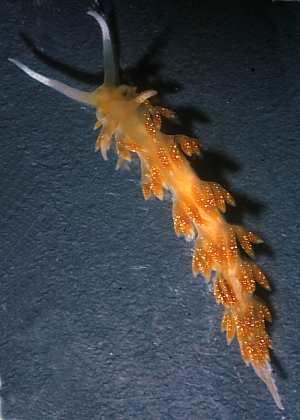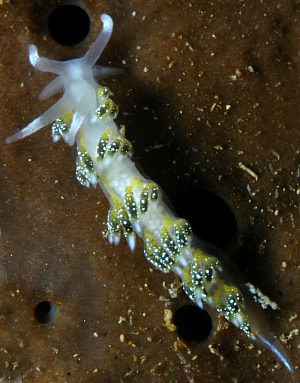

Tularia bractea
(Burn, 1962)
Order: NUDIBRANCHIA
Suborder: AEOLIDINA
Family: Flabellinidae
DISTRIBUTION
South-eastern Australia and New Zealand
PHOTO
Upper:Waiwera, east coast, nth of Auckland, 22 June 1963 [6 specimens on hydroids on Carpophyllum]. Photo M.C. Miller. Lower: Poor Knights Islands, 15 m, New Zealand, Pacific Ocean, 26 August 2007, Rocky reef. Length: 10 mm. Photo: Ian Skipworth.
The only information we have on this species is the original description (Burn, 1962) and a later redescription (Burn, 1966) of animals from Victoria, Australia, and Miller's full account (1971) of animals from New Zealand. Burns' description of the external features are not very clear, but fortunately in his 1966 redescription he describes the presence of lateral radular teeth, which with the ceratal arrangement and tentacular anterior foot corners, allowed Miller to identify his New Zealand specimens as this species. My description below, of the colour and external features, is based on the photos on the Forum of NZ specimens from Michael Miller and Ian Skipworth.
The animal is elongate with long tapering oral tentacles, and shorter, but similarly shaped, rhinophores which sometimes can have a wrinkled ventral section. The cerata are arranged in spaced rows, each row being on a ridge or bracket jutting out from the body. The first two rows of cerata on each side are quite close together, and because the cerata in the first row are quite small, this row can sometimes be overlooked, especially in photographs. Behind these first two rows the ceratal rows are regularly spaced at much wider intervals. The genital openings are on the right side between the second and third ceratal rows, and the heart is situated dorsally between the third and fourth rows. The anus and kidney openings are on the right side in the same space. The anterior end of the foot is extended into quite long tentacular foor corners.
The body wall is translucent white to transparent, with the whitish body organs showing through. Sometimes there can be a reddish orange or yellowish tinge over all the body wall, and in some animals there can be small brownish spots scattered all over the body and ceratal walls. There are usually opaque white spots scattered over the ceratal wall. Both the oral tentacles and rhinophores have a broad subapical band of opaque white, the actual tip being translucent. The posterior tip of the foot can also be opaque white and in some case there can be an opaque white median line running forward to the last ceratal row. The most distinctive part of the colour pattern is the colour of the digestive gland duct which runs along the length of the 'bracket' on which each row of cerata are attached, and sends a branch up into each ceras. The colour of the duct varies from yellow, orange, green or reddish brown, the colour intensifying in the upper half to a third of each ceras, just below the whitish cnidosac.
This species grows to about 17 mm in length. The triseriate radula and shape of the lateral teeth caused Burn (1966) to place the genus in the Eubranchidae, but Miller considered most other anatomical features suggest it is a flabellinid.
- Burn, R.F. (1962) Descriptions of Victorian nudibranchiate mollusca, with a comprehensive review of the Eolidacea. Memoirs of the National Museum of Victoria, 25: 95-128.
-
Burn, R.F. (1966) Descriptions of Australian Eolidacea (Mollusca: Opisthobranchia). 3. The genera Tularia, Embletonia and Austraeolis, with a note on Tergipes pauculas Burn, 1962. J. Mal. Soc. Aust., 9: 25-35.
-
Miller, M. C. (1971) Aeolid nudibranchs of the family Flabellinidae and Eubranchidae from New Zealand waters. Zoological Journal of the Linnean Society, 50: 311-337.
Rudman, W.B., 2007 (September 10) Tularia bractea (Burn, 1962). [In] Sea Slug Forum. Australian Museum, Sydney. Available from http://www.seaslugforum.net/factsheet/tulabrac
Related messages
-
Tularia bractea from eastern Australia
From: Leanne & David Atkinson, March 25, 2008 -
Another Tularia bractea from New Zealand?
From: Ian Skipworth, September 11, 2007 -
Tularia bractea from New Zealand
From: Bill Rudman, September 11, 2007 -
Tularia bractea from New Zealand
From: Ian Skipworth, September 11, 2007 -
Cuthona scintillans from New Zealand
From: Ian Skipworth, November 8, 2005
